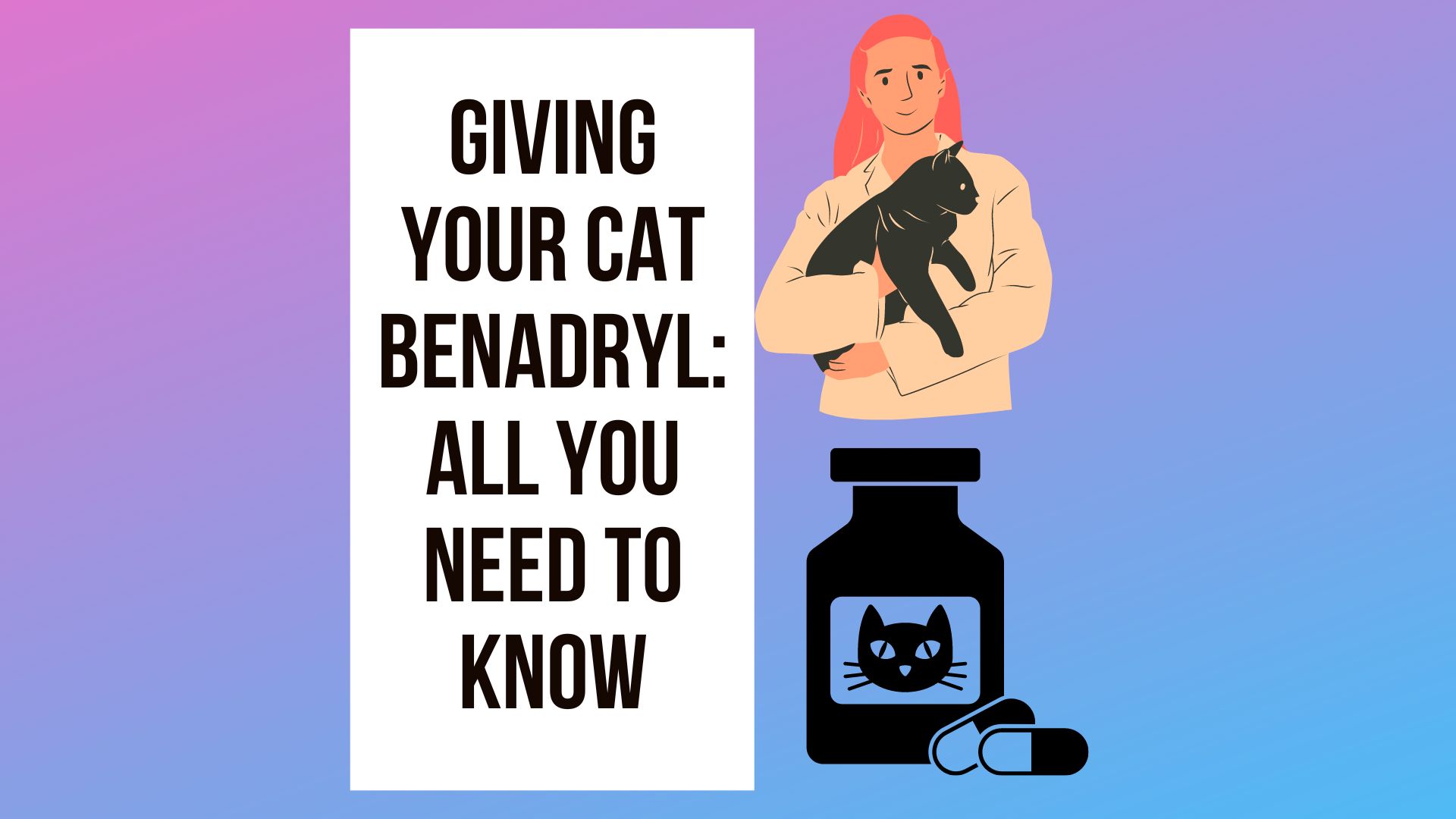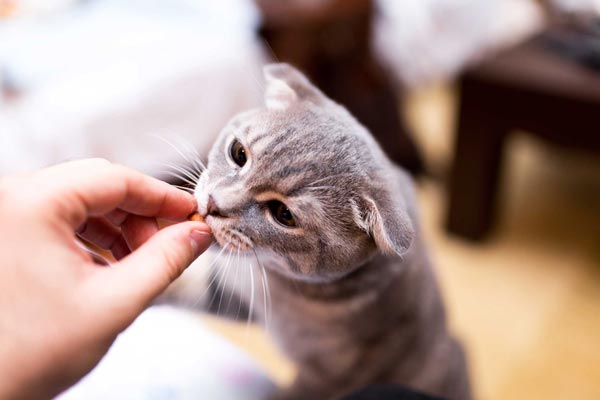
Humans often take Benadryl to help with a whole host of issues like allergies or the common cold. Benadryl can be equally as effective for our furry friends!
According to PetMd, many veterinarians will recommend that you give Benadryl to cats who are experiencing symptoms of an allergic reaction.
Is Benadryl Safe For My Cat?
Benadryl is totally safe to give to cats as long as you follow standard dosing instructions and know how to identify when your pet needs medication.
Benadryl contains diphenhydramine, which has been proven to be safe for animals. Some pet pharmacies, like Allivet, even sell diphenhydramine specifically geared towards pets.
You don’t have to buy pet-specific products. Human Benadryl works perfectly for cats and has been used by pet owners for decades.
There are several ways to give your cat Benadryl and we will review them, as well as what to expect from your pet, in the sections below.
How Much Benadryl Should I Give My Cat?
The standard rule for dosing is 0.4mL per one pound. A ten-pound cat should get 4mL of Benadryl.
Each cat reacts differently and some might need a little bit more or less of the drug.
Make sure that you don’t increase the dosage simply because the cat isn’t responding right away, as these drugs take a few minutes to kick in.
Give the Benadryl about thirty minutes to start affecting your pet. You will know then the Benadryl kicks in because the cat will seem a little bit more disoriented and might be excessively tired.
He or she could also have a lot of trouble balancing. One of the side effects of Benadryl is decreased motor skills in humans and in animals.
How Do I Know If My Cat Needs Benadryl?
Cats tend to need Benadryl just as people do. There are a few reasons why you might want to give your cat Benadryl.
- They have nausea or motion sickness.
- They are anxious and need to calm down.
- They are experiencing a rash or an allergic reaction.
Let’s talk about all of these reasons in detail.
If your cat has a sensitive stomach or is experiencing nausea from excessive licking or too many furballs, Benadryl might be just what the doctor ordered.
In many instances, it can quell stomach issues and make cats feel much better. Vetinfo indicates that Benadryl is extremely effective in controlling vomiting.
Cats who are anxious benefit greatly from Benadryl. Some owners will dose their pets before noisy guests or children come over.
Others find that certain holidays, like the Fourth of July, wreak havoc with their pets.
Cats are often afraid of the vet and a small dose of Benadryl will take the edge off their fears.
Just make sure that you’re not relying on Benadryl as a crutch to get your cat through day-to-day situations.
Some cats require a behavioral therapist or even different medication. Benadryl is excellent for occasional anxiety or to get the cat over a rough patch.
How Can I Administer Benadryl To My Cat?
You need to give Benadryl to your cat orally. You can do it one of three ways; a solid pill, a crushed-up pill mixed with a treat or food, or liquid form. We’ll run through the pros and cons of each method.
Administering Benadryl To Your Cat In Liquid Form
You’ll need to force the liquid down your cat’s throat with a syringe if you opt to administer Benadryl in this fashion.
Pros:
- You will be ensuring that the cat gets the entire dosage and that he or she swallows it completely.
- If done correctly the procedure will be over in a matter of seconds.
- The liquid mixture will start working quickly.
Cons:
- The force-feeding of Benadryl may traumatize your pet and cause it to distrust you in the future.
- The cat may react badly and scratch or bite the owner.
- The animal may be transported into a higher state of anxiety.
Administering Benadryl To Your Cat In Solid Pill Form
You will have to either coax your cat to swallow the entire pill or force the pill down its throat.
Pros:
- Your cat will be consuming the entire pill and getting the maximum benefits from the dosage.
- Even if you have to force-feed the cat, the entire ordeal will be over quickly.
Cons:
- The cat could refuse to eat the pill and you might have to force him or her to eat it.
- The animal could need minutes of coaxing to ingest the pill, wasting valuable time.
- The cat could easily bite or scratch if spooked, creating a more dangerous situation for the owner.
Administering Benadryl To Your Cat In Crushed Pill Form
If you want to use this method, you’ll need to crush up the pill and incorporate it into your cats’ food or a treat.
Pros:
- The cat will probably eat the dosage without even knowing it.
- There will be no time wasted coaxing the cat to eat the pill.
Cons:
- Even if you hide the crushed pill in a treat or food, the cat could still sniff it out and refuse to eat it.
- It’s possible for the cat to only eat part of the pill.
The method that you choose is totally up to you! If you decide to feed your cat the whole pill VetVids has a great video that shows how to do it step by step.
They recommend that you blow on your cat’s nose after feeding him or her the pill. Apparently, this triggers the natural impulse to lick the nose and helps the pill go down easier.
No matter how you go about giving your cat Benadryl, it is important to remember that you must maintain calm energy and be patient with your pet.
You should make your furry friend feel as comfortable as possible by speaking in a calm, authoritative voice and stroking their head.
It is advisable to trim your cat’s nails before administering any medication. Even the calmest cats might react badly and can lash out by scratching or biting.
Eliminate your risk by trimming the nails. If appropriate, cloak your cat in a towel before attempting to administer the medication.
Some cats feel more comfortable swathed in a towel and are less likely to react aggressively.
You know your cat better than anyone else. If you have built up a system of trust with the animal, you’ll be able to administer Benadryl more easily.
Are There Any Side Effects Of Giving Benedryl To My Cat?
Benadryl is strong medicine for both humans and animals, and it comes with a few different side effects.
The most common side effects of Benadryl are sleepiness and slight disorientation. You might notice that your pet is breathless and panting.
If this happens, get them to the veterinarian as soon as possible because your pet might be having a seizure.
Monitoring your cat’s behavior is absolutely essential, as overdoses can often be fatal to our beloved pets.
If you follow the chart linked earlier in this article you should be ok, but it never hurts to be on the safe side!
In case your cat is on other medications always make sure that you contact your veterinarian to make sure that Benadryl will not interact poorly with the other drugs.
If your cat is on certain medications, like Diazepam for anxiety, he or she could have a very negative response to Benadryl.
How Do I Know If My Cat Is Overdosing On Benadryl?
There are several ways to know if your feline friend needs to see a veterinarian right away. We’ve outlined them below.
Your Cat Is Experiencing Excessive Fatigue
Fatigue is a normal side-effect of Benadryl, but if your cat is unresponsive and completely lethargic, he or she might have had too much medication.
It is okay for your cat to take longer naps, but they should be waking up at regular intervals. If your cat doesn’t engage with treats, catnip or their favorite toy at all, there might be a problem.
Your Cat Is Suffering From Diarrhea
Diarrhea is a dangerous symptom in cats because it might indicate that they are experiencing dehydration. If your cat is having bouts of diarrhea after taking Benadryl, it is time to consult a veterinarian.
Your Cat Is Vomiting
Benadryl is usually used to help cats stop vomiting. If they start vomiting after taking the medication, there could be a problem.
You cat might have taken too much, or maybe it even having an allergic reaction to the Benadryl.
It might seem counterintuitive to think about cats having allergic reactions to an allergy medication but it definitely happens. If your cat starts vomiting take them to the veterinarian right away.
How Long Can I Expect The Effects Of Benadryl To Last On My Cat?
Although all cats are different, the general rule is that you can expect your cat to be under the influence of Benadryl for a good 8 to 12 hours.
During this time period, your pet might exhibit a loss of appetite, increased drowsiness and imbalance.
On the other hand, some cats become hyperactive after taking Benadryl and enjoy huge bursts of energy followed by periods of relaxation. This is totally normal too.
Your cat also might need to urinate more often after taking Benadryl. This is totally normal as long as it doesn’t become excessive or manifest itself in diarrhea.
You might have to change the litter a little bit more often in order to allow your cat to feel comfortable.
After giving your cat Benadryl respect for his or her need to take a nap. Provide a comfortable, warm, and inviting place for your cat to lay its head.
If your cat doesn’t respond enthusiastically to food, don’t worry. Simply leave out some dry food for when the cat begins to feel hungry again. Soon enough, he or she will be totally back to normal.
Conclusion: Give Your Cat Benadryl Safely And There Should Be No Problems
Veterinarians have absolutely no problem with people giving their cats Benadryl. In many cases, they actually encourage it!
As long as you follow standard dosing rules and remember that each cat is different, you should be completely fine and safe giving your cat Benadryl.
Remember not to give your cat an additional dose because the medication is not working right away.
It takes thirty minutes for Benadryl to kick in, so it is important to be patient and allow the drug to do its job.
If you give your cat an additional dose you risk overdoing it and having to make an emergency vet visit!
All cats are different and all react in various ways to Benadryl.
Some tend to get really sleepy and withdrawn.
Others have a short burst of hyperactivity. Don’t worry about these strange behaviors; unless your cat is lethargic to the point of being unable to wake up or respond to stimuli, vomiting, or having excessive diarrhea, you are probably fine.
Check with your veterinarian and make sure that no medications interfere with Benadryl. Many anti-anxiety medications could cause negative side effects. Look out for any drugs billed as “cat Valiums”.
How you administer the Benadryl is totally up to you. Only you have a special and unique relationship with your cat and can determine how best to deliver the medication.
As long as you approach your pet kindly and with calm authority, you should be fine.
Giving Benadryl to your pet is easy if you follow the instructions in this article!

Hi, This is Alexa, and I love cats. This Website is a Complete Journal about how to travel with a cat and other information about Cat Health, Cat Training, Cat Behavior, Cat Foods and more. I hope you find it useful.

